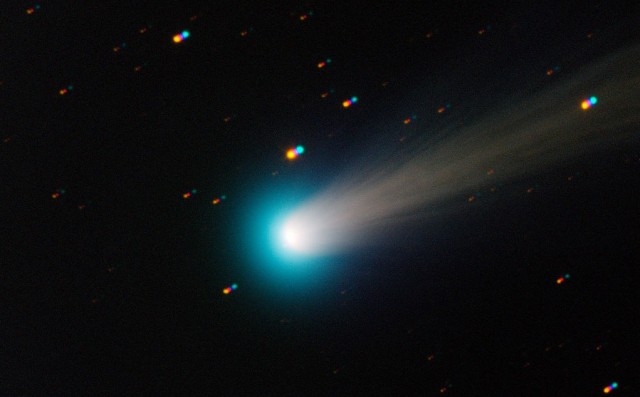
We’ll know soon whether Comet ISON will blaze through our sky this December or be burnt up as it grazes the sun [Image credit: TRAPPIST/E. Jehin/ESO via Wikimedia Commons]
Today’s space weather: Awesome or business as usual? We don’t know yet.
Scientists first noticed Comet ISON racing toward us in 2012, when it was about as far away as Jupiter. People got a bit excited, calling it the “Comet of the Century” and guessing it’d be as bright as the moon this December. Many compared it to the Great Comet of 1680, which was visible over various parts of Europe for almost a month.
A pair of Russian astronomers using an International Scientific Optical Network (ISON) observatory first discovered the comet, and just 30 hours later a telescope that automatically scans for comets at MIT found it independently. Like the Great Comet of 1680, Comet ISON is a rare sun-grazing comet, coming from afar to brush past the sun.
It now looks like ISON won’t quite be another Comet of the Century, nor will it be as bright as initially expected. Nonetheless, it came back brighter than ever after reports of its disappearance last month, and may soon be visible to the naked eye and quite spectacular. If it survives its close encounter with the sun, that is.
A bit before 2 p.m. EST on Thanksgiving Day, the comet (video), largely made of ice, will be making a dangerous journey within 730,000 miles of the sun. That’s 125 times closer than the Earth dares approach – and we’re not an ice ball a few miles wide.
If ISON doesn’t disintegrate as it approaches, and isn’t abruptly swallowed by a solar storm, we should be able to see it once it re-emerges from behind the sun and starts approaching Earth. It should be visible to the naked eye at about 30 minutes before sunrise on November 30 and then stay visible and bright at night in December until it fades away, possibly as late as the beginning of January.
But first, ISON has to survive Thanksgiving Day.
Follow NASA’s Google Hangout Thursday starting at 1 p.m. EST for live updates on the state of the comet.